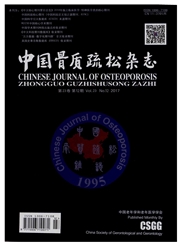

 中文摘要:
中文摘要:
目的考察大血藤不同极性部位的体外抗氧化活性及对过氧化氢诱导成骨细胞氧化损伤的保护作用。方法以清除1,1二苯基苦基苯肼(DPPH)自由基、Fe^3+还原能力(FRAP)和2,2-联氮-双-(3-乙基苯并噻唑啉磺酸-6)二铵盐(ABTS)自由基3种方法为指标,评价大血藤不同极性部位的抗氧化能力。另外,用过氧化氢作用成骨细胞(MC3T3-E1Subclone 14),建立成骨细胞氧化应激模型。通过MTT法测定模型组和药物组的细胞活力并测定超氧化物歧化酶(SOD)、细胞总抗氧化能力(TAOC)生化指标来判断细胞抗氧化能力。结果大血藤醇提物的各个极性部位均具有一定的抗氧化作用,其中以乙酸乙酯部位抗氧化能力最强(DPPH IC500.059 g/L,FRAP 1.072 mmol/g,ABTS IC_(50)0.439 g/L),其他部位抗氧化能力依次为正丁醇部位〉水部位〉石油醚部位。用1 m M/L过氧化氢作用成骨细胞1 h可造成氧化应激模型,实验证明,大血藤各极性部位低、中、高剂量组均具有一定预防氧化损伤的作用,其中乙酸乙酯部位保护作用最强,并具有一定的剂量依耐性,细胞的存活率由49.36%分别上升至60.67%、64.27%、69.47%;其次分别为正丁醇部位、水部位和石油醚部位,其机理可能是大血藤各极性部位能够剂量依赖性地增强超氧化物歧化酶(SOD)、过氧化氢酶(CAT)和谷胱甘肽过氧化物酶(GSH-Px)等酶的活性。结论大血藤不同极性部位对氧化应激损伤成骨细胞具有保护作用,其作用可能与抗氧化相关活性成分有关。
 英文摘要:
英文摘要:
Objective To study the antioxidation effect of different extracts from Sargentodoxa Cuneata in vitro and to study the protective effect on osteoblasts damage induced by oxidative stress. Methods The antioxidation ability of the four fractions was tested by 1, 1-diphenyl-2-picrylhydrazyl (DPPH) radical scavenging activity, ferric reducing antioxidant power (FRAP) assay, and 2, 2-amino-di (3-ethyl-benzothiazoline sulphonic acid-6) ammonium salt (ABTS) radical scavenging activity. Osteoblasts damage induced by hydrogen peroxide (H2O2 ) was chosen to establish the model of oxidative stress. The proliferation of model group and medication group was observed using MTT assay. The antioxidative capacity was judged with SOD and T-AOC determinations. Results The antioxidant activities : ethyl acetate extract 〉 n-butanol extract 〉 water fraction 〉 petroleum ether extract. H2O2 injury for one hour could establish the model of osteoblast oxidative stress. Medication with Sargentodoxa Cuneata ( low-dose, medium- dose, or high-dose) of different extracts prevented and decreased oxidative damage. The effect of ethyl acetate extract was better than others, which increased the survival rate of cells from 49.36% to 60. 67% , 64. 27% , ad 69. 47% , respectively, followed by n-butanol extract, water fraction, and petroleum ether extract. The activities of SOD, CAT, and GSH-Px in cells increased in a concentration-dependent manner. Conclusion The different extracts of Sargentodoxa Cuneata have an protective effect on osteoblasts which are injured by oxidative stress. The effect might be related to the correlated antioxidant activity.
 同期刊论文项目
同期刊论文项目
 同项目期刊论文
同项目期刊论文
 期刊信息
期刊信息
